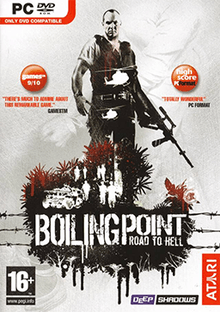Boiling Point: Road to Hell
Boiling Point: Road to Hell (Xenus: Точка кипения, Xenus: Boiling Point) is a video game developed by the Ukrainian game studio Deep Shadows and published in 2005 by Atari. Boiling Point's gameplay is a combination of open world, FPS, and role-playing video game mechanics. Critical response upon its release was, with few exceptions, lukewarm. This was attributed to the many technical issues that plagued the game's release: bugs, glitches and choppy performance. Patches have been released that address many, but not all, of these deficiencies. Deep Shadows released a successor in 2009 called White Gold: War In Paradise, and another game with the same engine called The Precursors.[1]
| Boiling Point: Road to Hell | |
|---|---|
 | |
| Developer(s) | Deep Shadows |
| Publisher(s) | |
| Engine | Vital Engine |
| Platform(s) | Microsoft Windows |
| Release |
|
| Genre(s) | Role-playing first-person shooter |
| Mode(s) | Single-player |
Premise
Boiling Point's protagonist is Saul Myers (whose character model is based on actor Arnold Vosloo), a veteran of the French Foreign Legion living abroad in Paris. Myers' daughter, Lisa, is a globetrotting journalist. Lisa runs afoul of and is kidnapped by persons unknown while working in the fictional, troubled South American nation of Realia. News of this is quickly relayed to Myers, who hastily departs for Realia, where he must tangle with local politics and the criminal underworld while trying to track down his missing daughter.
Gameplay
The game is set in a Realian valley, an undivided 25x25km (625 km2) map. There are no in-game loading screens or level transitions. The geography of the valley itself is tropical jungle. There are two primary cities: Puerto Sombra in the west, which is in the hands of the local government, and Pueblo Faro in the east, which is held by communist insurgents (see: Factions). Scattered throughout the rest of the valley are various bases, plantations, villages, and estates. Due to the large size of the game world there are several modes of transportation available: cars, trucks, tanks, planes, helicopters, and boats.
Gameplay is a hybrid of FPS and RPG mechanics. Character advancement is skill-based, with specific skills either being enhanced through practice, or atrophied via disuse. The list of skills is limited, and is constructed of weapon proficiencies and physical ability. However, killing everything in sight is not the goal of the game. Saul Myers' goal is to find his daughter, so he will need to talk to many people to gather the necessary information to unravel the mystery of her disappearance. Much of this information can only be purchased with the Realian currency, and the primary means of generating income is by completing missions for the game's various factions.
There are no predefined enemies in the game except for hostile animals such as snakes and jaguars in the wilderness. There are many NPCs, with almost all of them being neutral at the start. There are six factions in the game: the Realian government, the communist guerrillas, the mafia, local Indian tribes, unaffiliated bandits, and an American CIA presence. Civilians are also considered a faction for the purposes of calculating Myers' "reputation", which is variable and dynamic. Completing missions for a faction's rivals will lower Myers' reputation with them, and hostile factions will shoot on sight. There are, however, methods of repairing Myer's reputation.
Reception
Due to the buggy nature of the game unpatched, reviewers who rated the game when it first came out were heavily critical of the game, with a reviewer from PC Gamer magazine saying "Unless it receives some extreme patching, don't bother with this game." At the same time, reviewers who either looked past the buggy issues, or were late to review and therefore able to patch the game to the reportedly stable 2.0 version, were largely positive, with a reviewer from gamesTM saying "Atari has landed itself an absolute classic here. A must-have - no questions asked." Edge magazine would bemusedly quote from the patch notes a few months later and observe that the removal of the game's bugs had removed much of the game's limited entertainment value.
See also
References
- Deep Shadows (16 July 2008). "Deep Shadows Announces Optimization of White Gold and Precursors for Intel-based Multi-core Processor Systems". Archived from the original on 6 October 2015. Retrieved 2014-06-12.